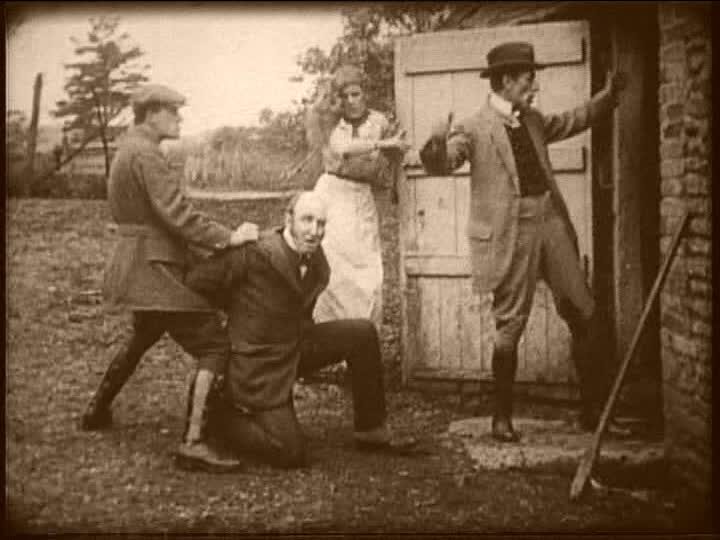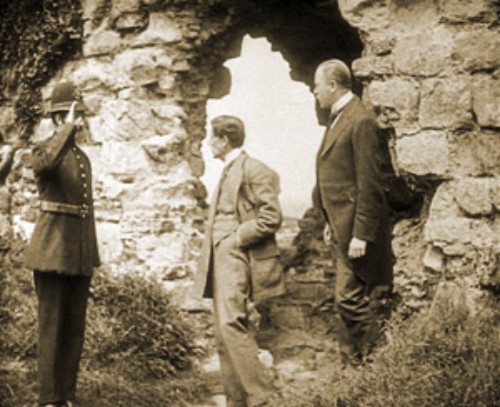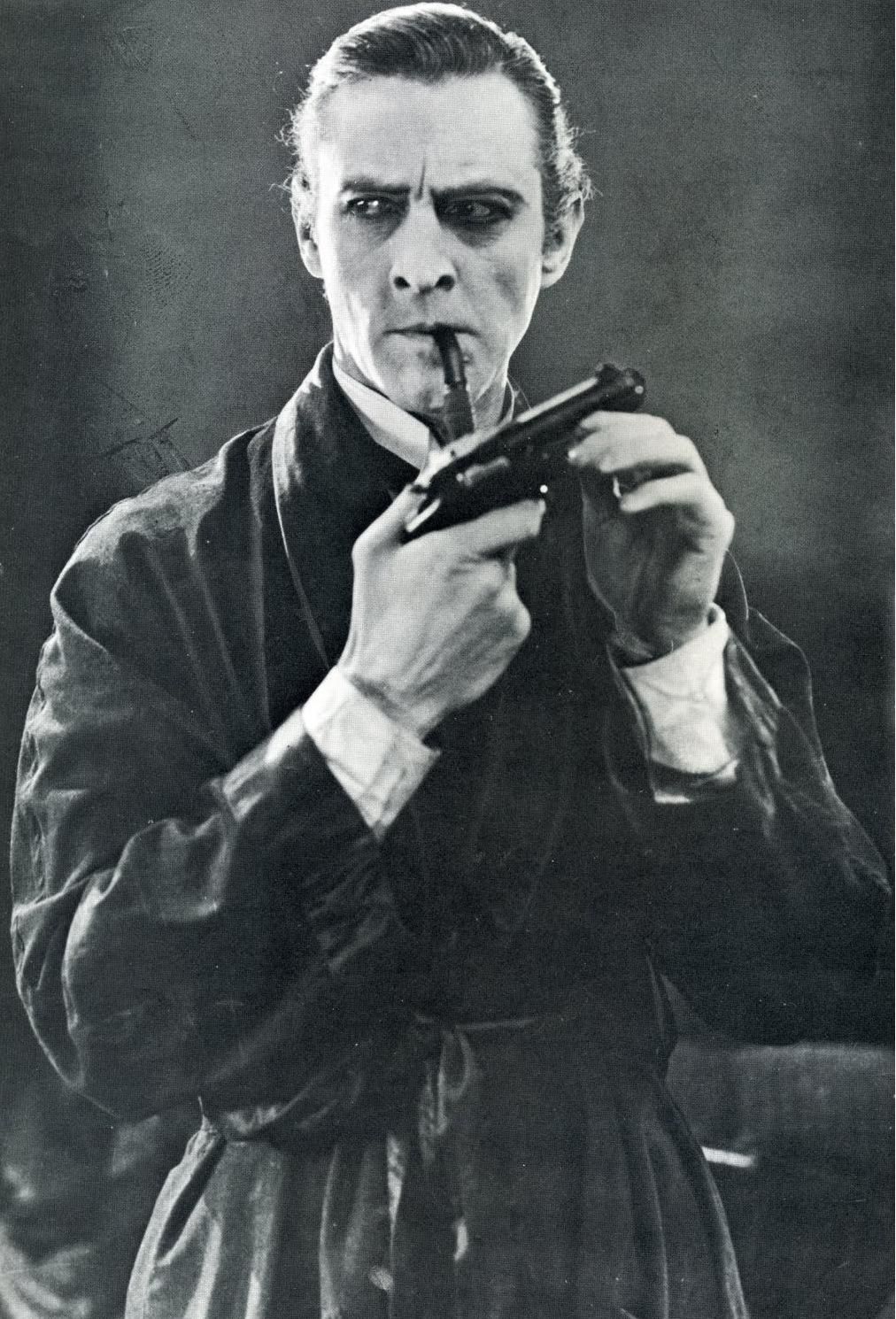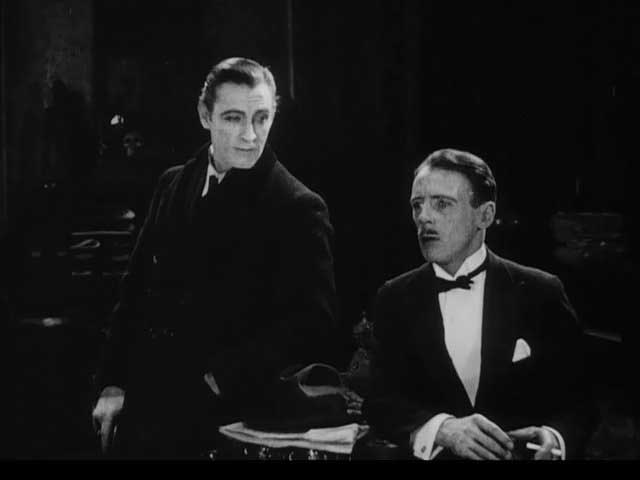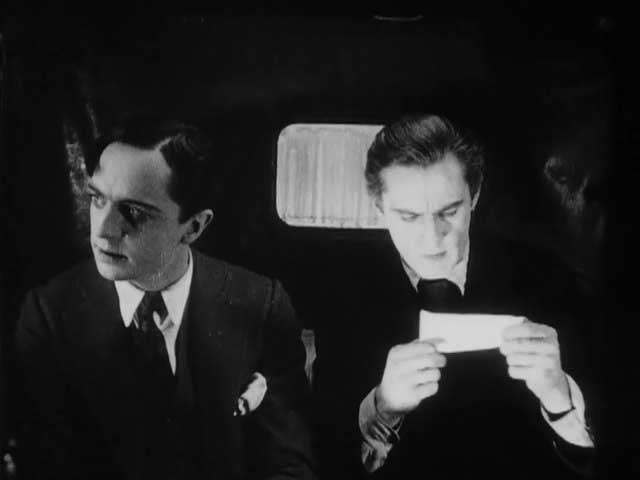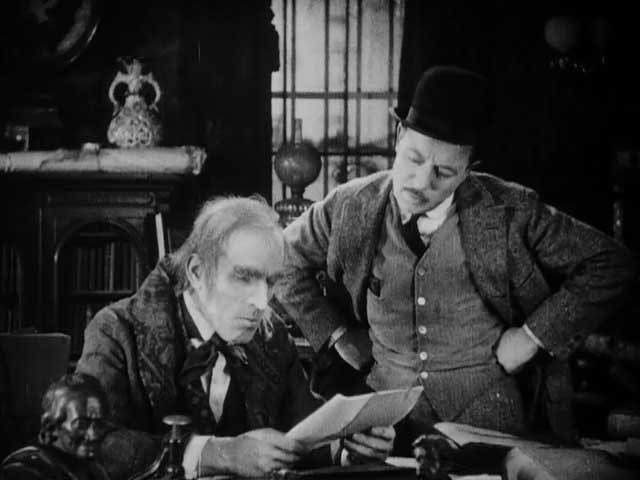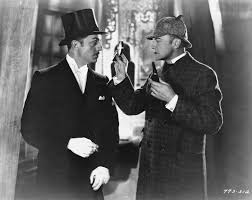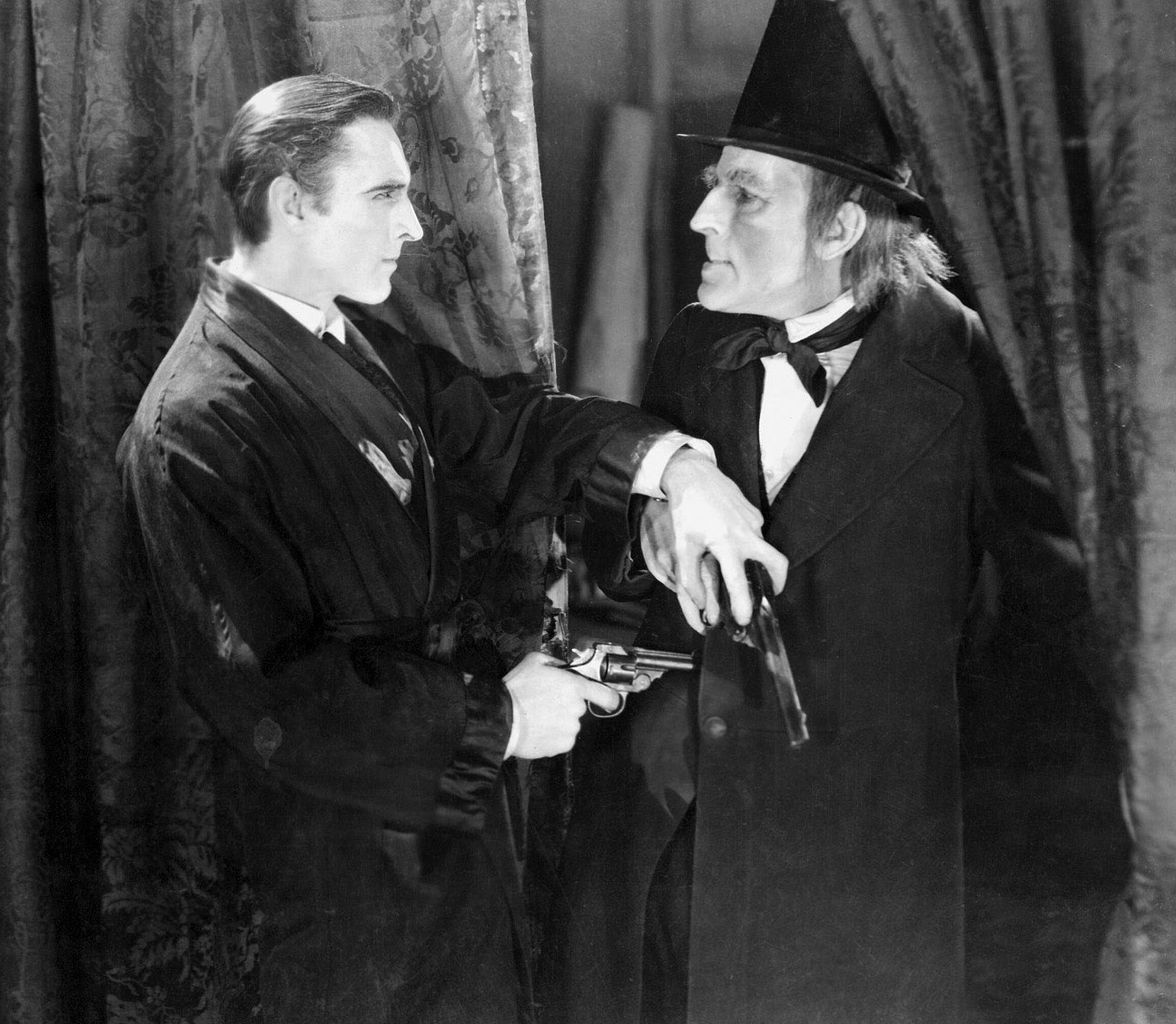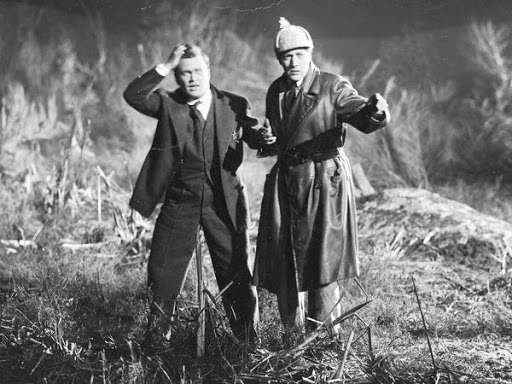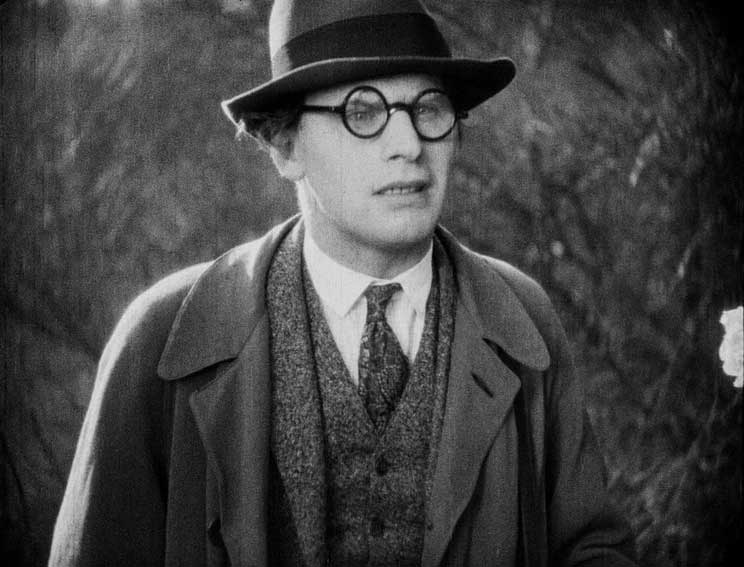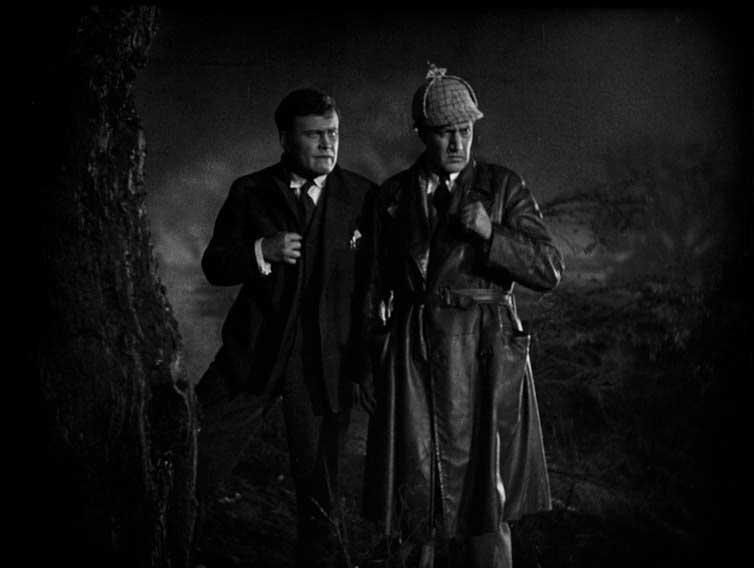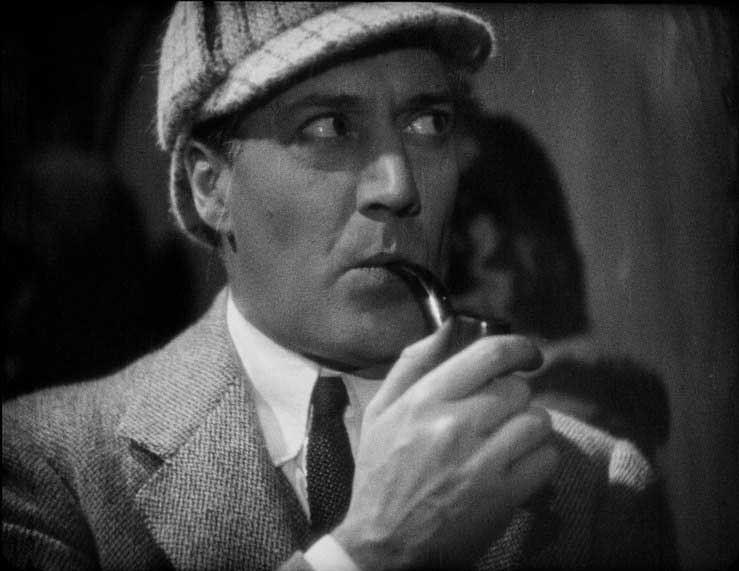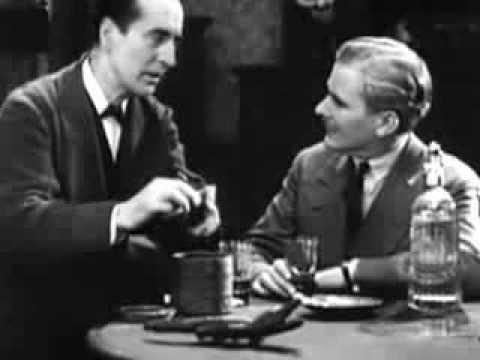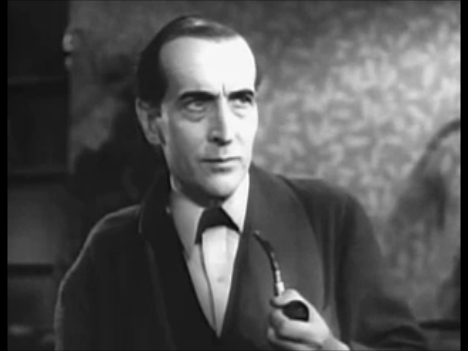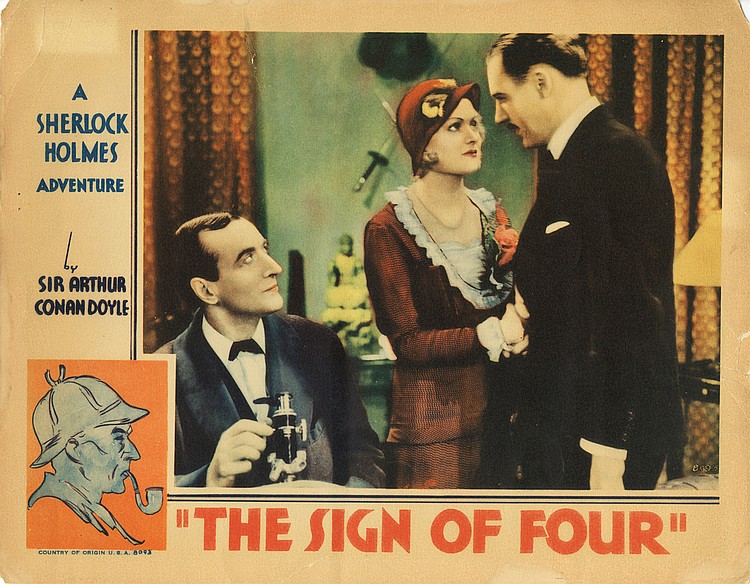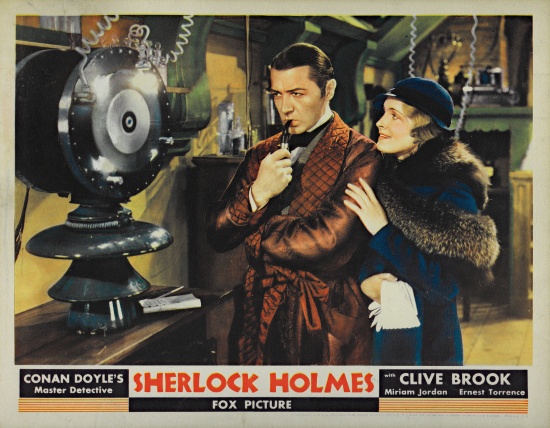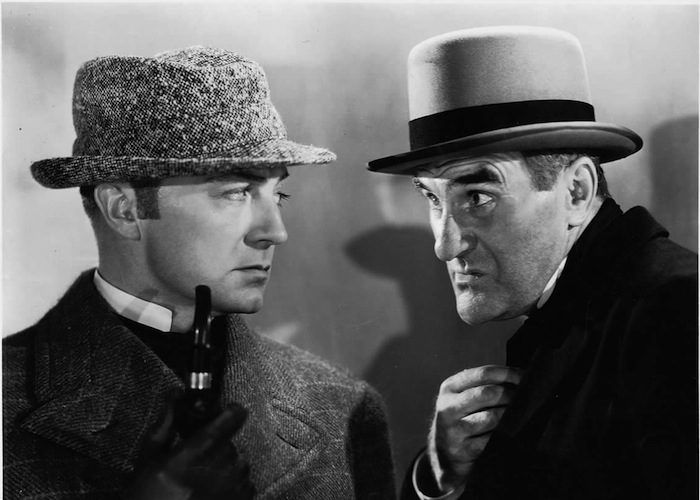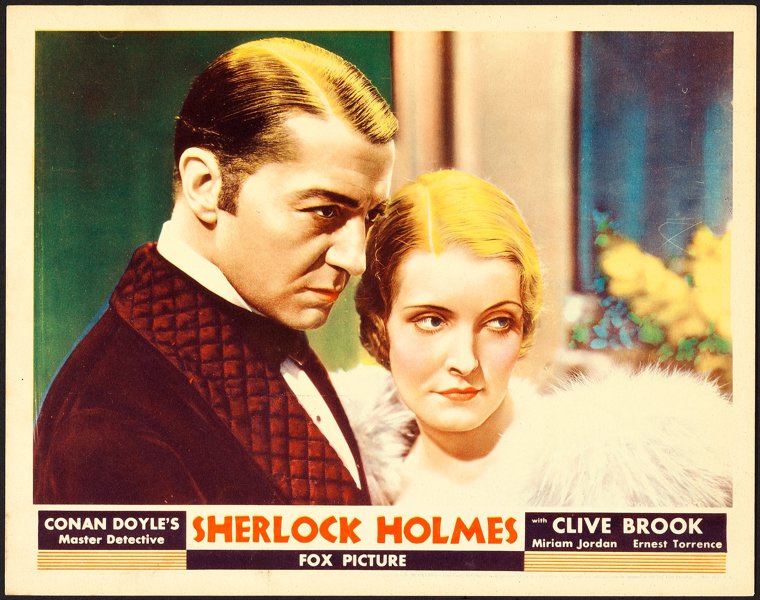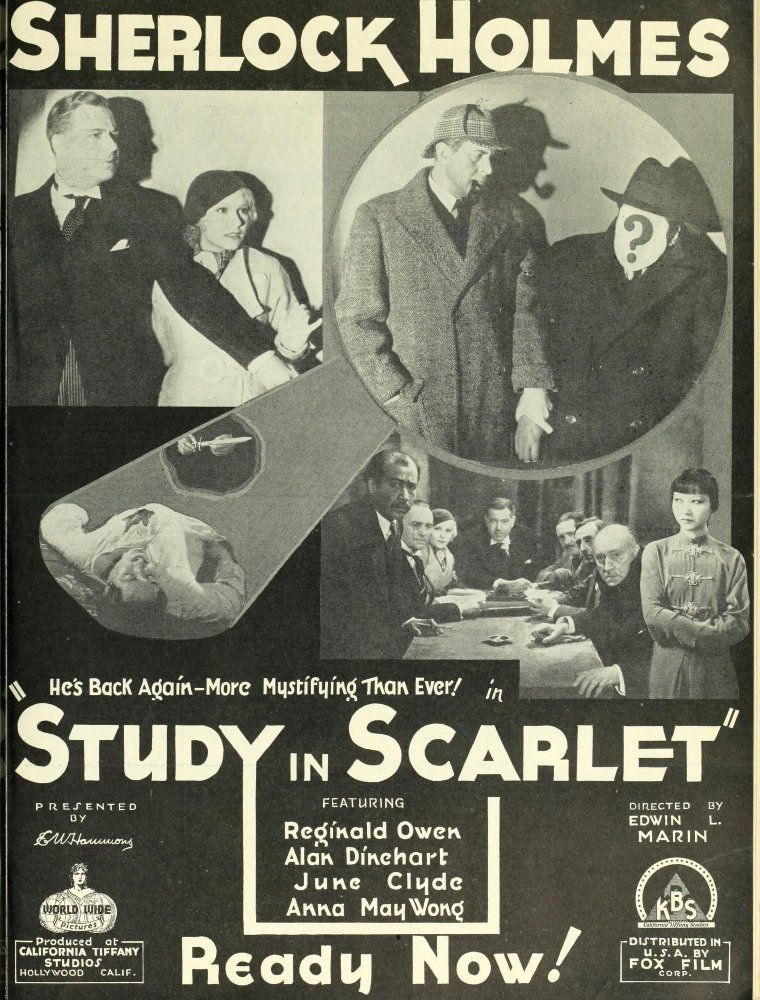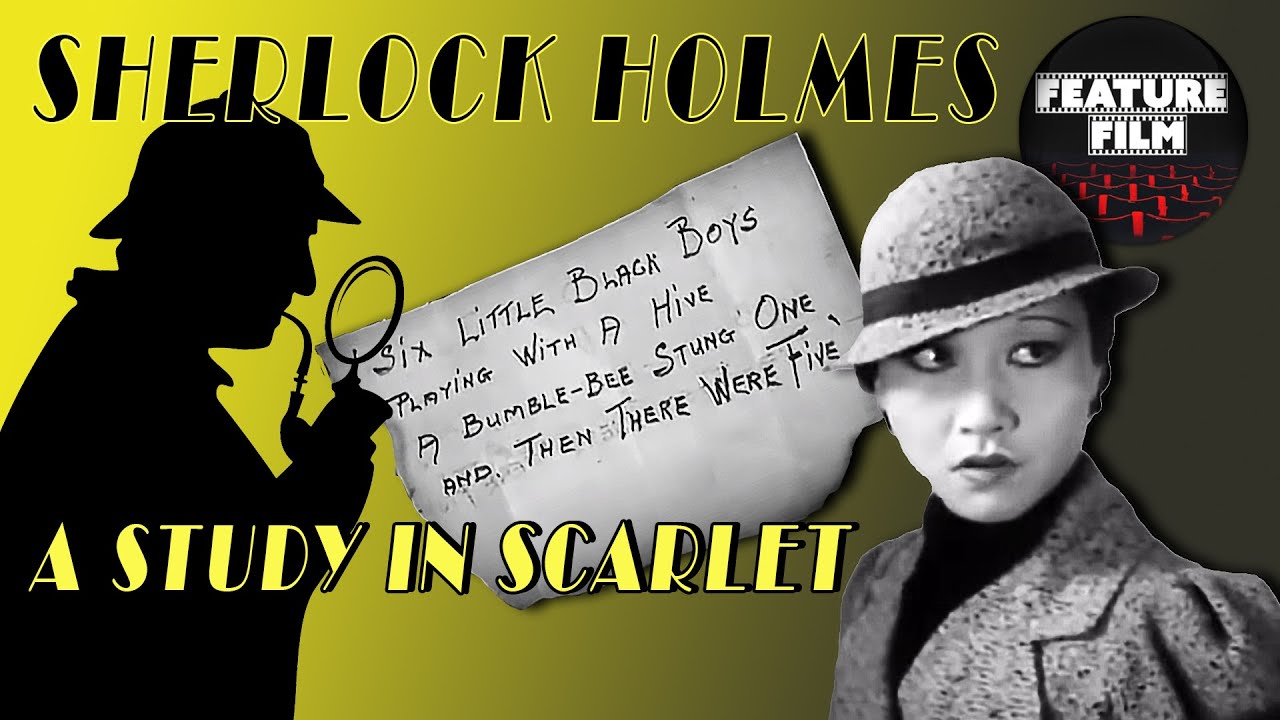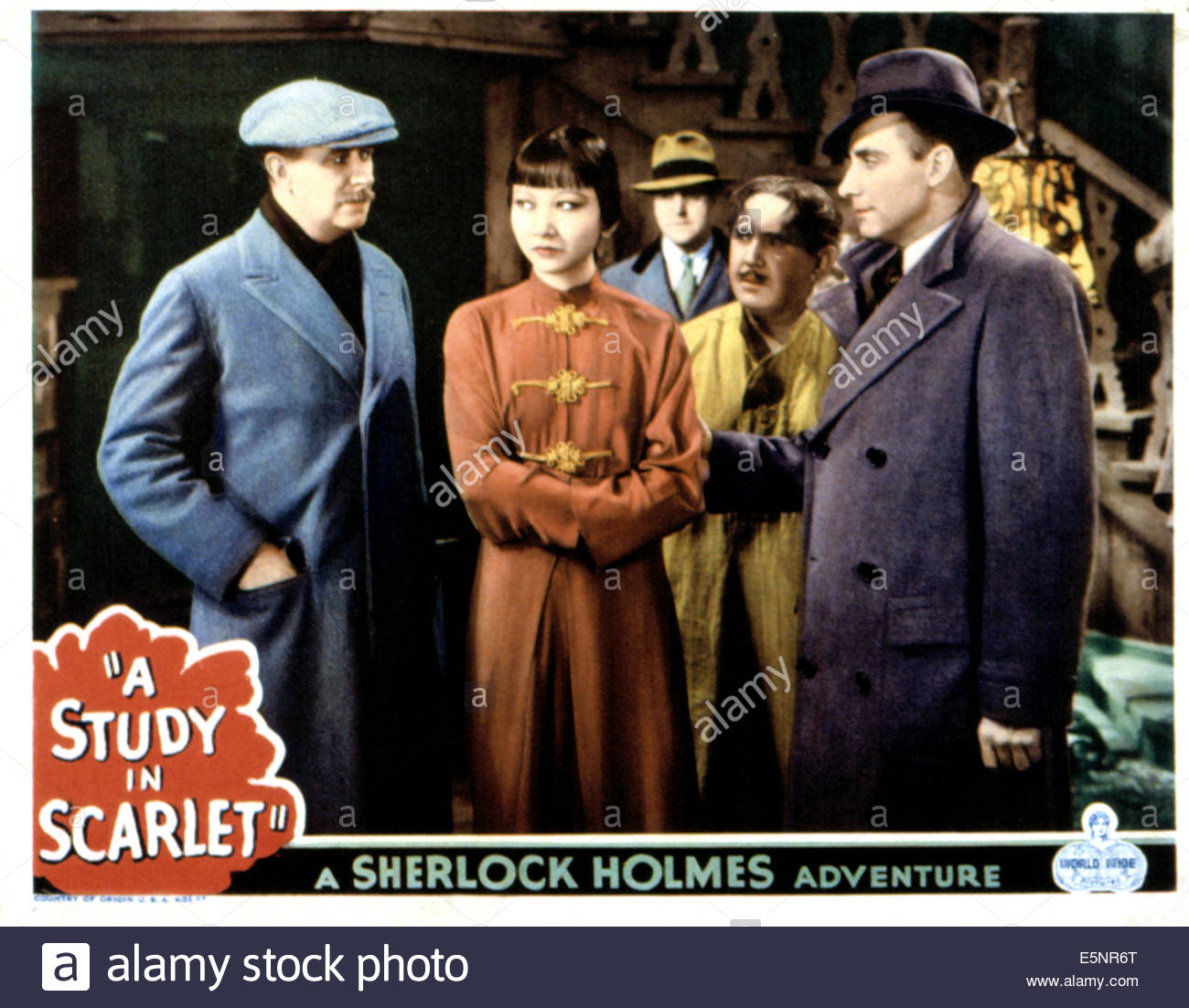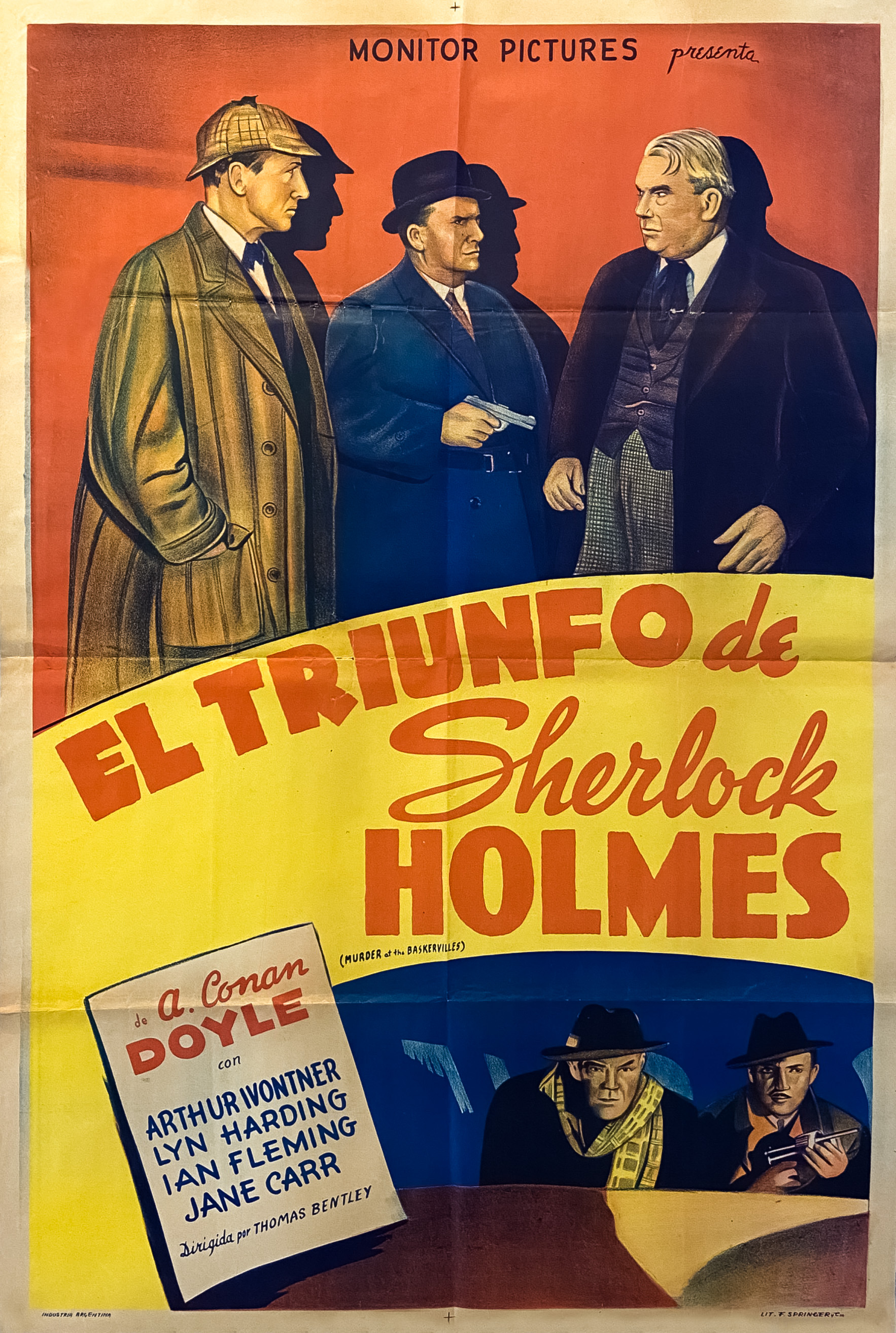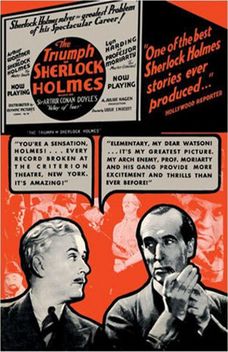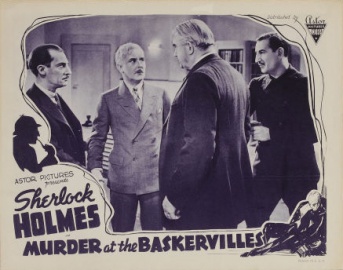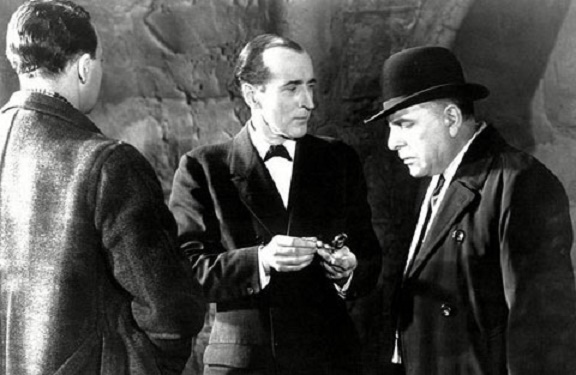Early Sherlock Holmes
Films
The Copper Beeches (1912) – 5/10
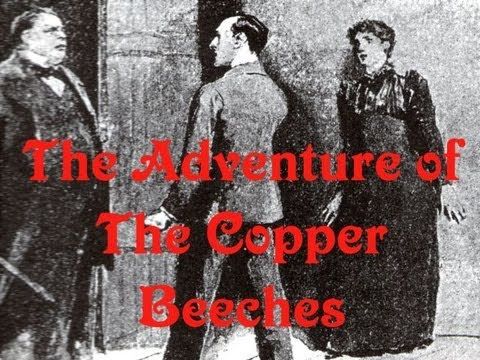
This is more of a curiosity than anything really. This is the earliest Sherlock
Holmes' film that is still in existence. There was a 1903 film called Sherlock
Holmes Baffled but only about 60 seconds of it exists though perhaps that
is all there was. The Copper Beeches runs for 23 minutes and is based on
the story from Arthur Conan Doyle of the same name. In fact, the opening
credits claim that Doyle helped supervise the film. Who knows. It is similar
to the short story.
This is a French production and stars George Treville who was to go on to
star in seven more Holmes short films - all in 1912! In this film and another
that I have seen there is no Watson. That makes sense for this one as the
short story is narrated by Holmes to Watson. It would be impossible to watch
this and actually expect anything good - it was 1912! But it is quite wonderful
that it still exists and is in very good condition.
The Musgrave Ritual
(1912) – 5/10
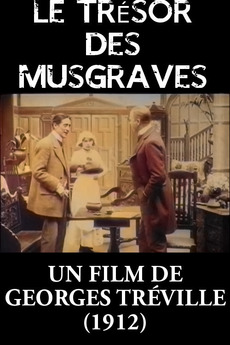
Based on the Arthur Conan Doyle short story of the same name. Treville who
portrays Holmes was in eight Holmes films all together - all made in 1912.
As far as I have been able to figure out only this one and The Copper Beeches
have survived - both are up on YouTube. This one runs about 17 minutes.
I wonder if people back in those days were smarter than we are now because
I often have trouble figuring out what is going on in silent films especially
if cards are few and far between. For both films I had to read up on the
Doyle story to really understand what was happening. And they are by no means
complicated! These are the first of the silent Sherlock Holmes films that
we can see and for that reason - and pretty much only for that reason - are
worth seeing.
Sherlock Holmes
(1922) – 5.0
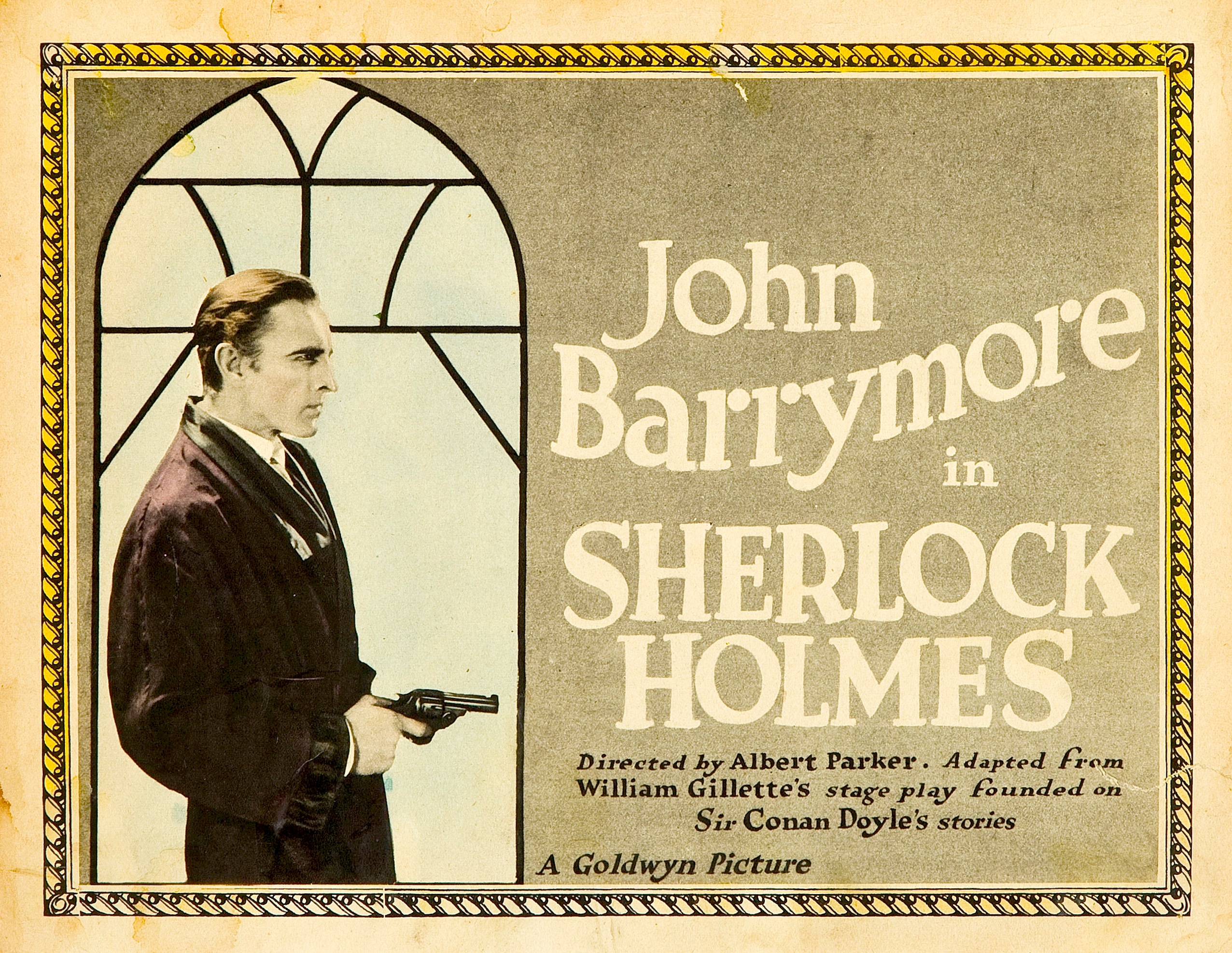
A fairly good copy of this silent film is up on YouTube. It had been lost
for decades but was found and restored. In itself it is middling - decent
but doesn't generate much buzz and shows little inventiveness with camera
movement or the cinematography - but in its way it has historical merit for
the actors in it. The Great Profile also known as John Barrymore is Sherlock
Holmes. He was already famous by this point though more for his performances
on the stage - Hamlet in particular - than in film. He was from a famous
acting family with his brother Lionel and sister Ethel. He is a fine Holmes
with the right look though there is only so much he can do in a silent film.
A few other to be famous some day actors are here.
As Watson in his debut is Roland Young, who once films talked used his droll
charm so wonderfully in films like Ruggles of Red Gap and the Topper films.
His role is small here but he is very recognizable even with a full head
of hair. Also, in his first role playing a thief and then turned to be one
of Holmes's agents is William Powell - until later in the 1920's with his
role as the detective Philo Vance, he was usually cast as a villain. And
one more person who became famous not as an actor but as a gossip columnist.
Hedda Hopper started off in show business married to an actor, then became
one in small roles but made a lot of connections with people like J. Edgar
Hoover and studio heads and in 1936 began her career as a media gossip. Very
right wing and vicious at times, she was hated by many. She had one son -
Paul Drake ie William Hopper of Perry Mason fame. She plays the wife of one
of the bad guys.
As I said the film is slow and is a very loosely based on Doyle's A Scandal
in Bohemia but they throw in Moriarty, Holmes as a student and Holmes going
off on his honeymoon! What the hell. These bits are actually based on the
Holmes play that William Gillette put on for decades. Gillette was most associated
with Holmes from the late 1800's until the early 1930s appearing as Holmes
in the theater all those years. He wrote the plays of Holmes, even popularizing
many of the tics that we think of as Doyle but were actually Gillette and
then picked up by other actors. He made only one film - the 1916 Sherlock
Holmes, also lost and discovered and up on YouTube.
It begins with a 40 year old Barrymore portraying Sherlock in college - at
Oxford - where his friend Watson convinces him to help Prince Alexis from
some European country who has been accused of stealing. Prince Alexis is
also played by a familiar name - Reginald Denny who was a character actor
for years in Hollywood - the sidekick in many of the Bulldog Drummond films.
Sherlock quickly figures out that another student Wells (Powell) stole the
money and is under the control of a mysterious kingpin of crime - yes - Moriarty!
Holmes has a face to face chat with the villain and concludes that he will
devote his life to bringing him to justice. Moriarty is portrayed by an actor
whose name I will never be able to remember but whose face is unforgettable
- Gustav von Seyffertitz. In the film he is a Dickens Fagin like character
with a gang, informers that are everywhere and a very down at the heels lair.
His gnome facial features stick out in later films like Mr. Deeds Goes to
Town and Murder on a Bridle Path.
Jump 20 years or so into the future and Holmes has settled into 221 Baker
St and Watson is married and Moriarty still runs the criminal underworld.
A woman is threatening to release letters that Prince Alexis wrote her sister
years ago that will bring down the Royal family. It is not Irene Adler as
in the book but a woman that Holmes saw once long in the past and has never
forgotten. He needs to save her, save the Prince and get Moriarty!
Der Hund von Baskervilles
(1929) – 6.5
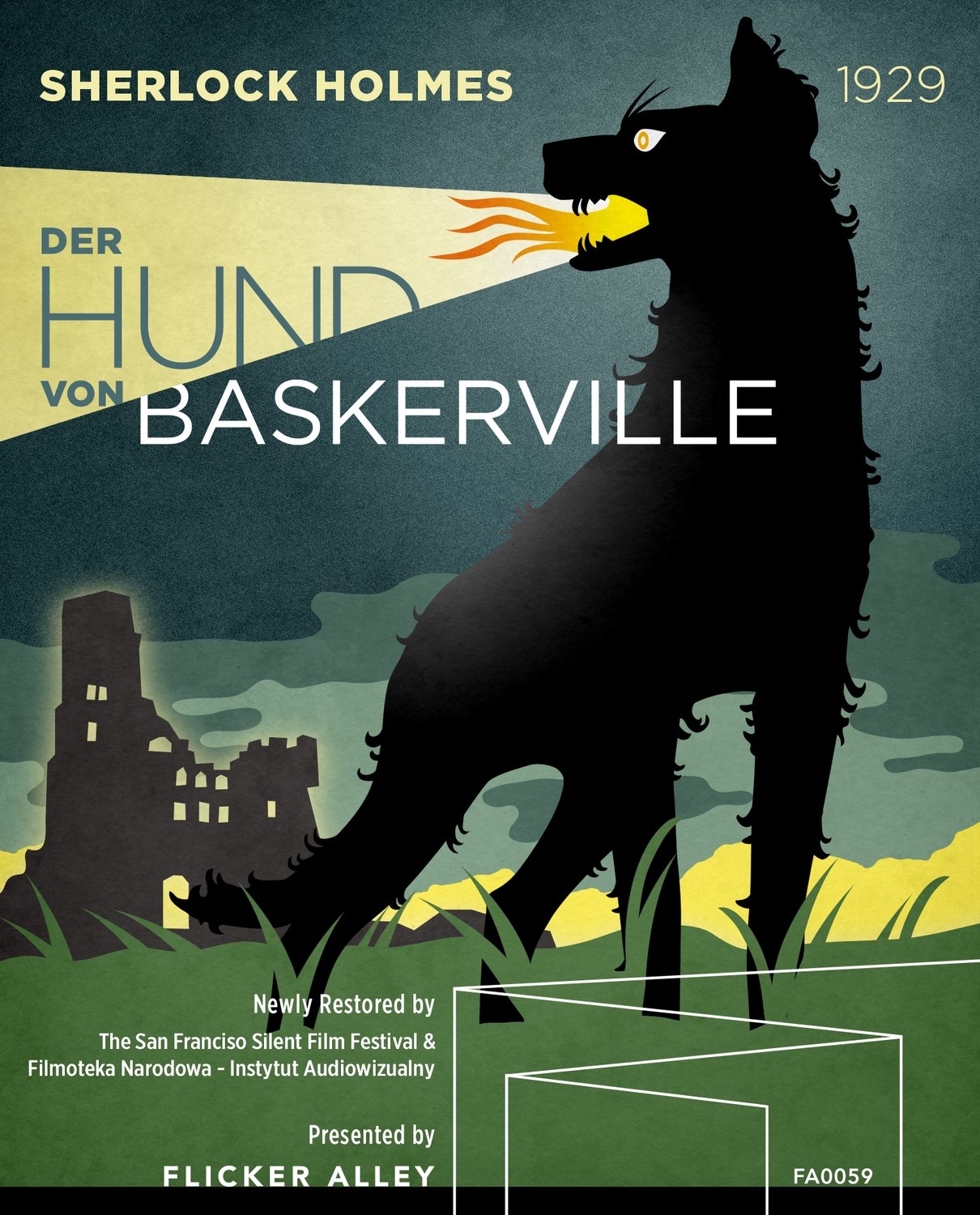
Aka - The Hound of the Baskervilles
The last of the silent Sherlock Holmes films. From Germany. It is heads above
the other early Holmes films that I have seen - those by Wontner who portrayed
Holmes in five films in the early 1930's. And a Study in Scarlet with Reginald
Owen in 1933. All fairly dull going - stodgy and stuck in place. It isn't
that the actor playing Holmes here is all that charismatic but the film is
wonderfully shot, has imaginative sets with a hint of Expressionism and is
crisply edited - in particular in the terrific final fifteen minutes that
has multiple things going on at the same time. This was considered a lost
film for decades until it was discovered in the basement of a Polish church
where the priest had been keeping it and a few others hidden against the
order of the Church. It was restored in 2018 but has about 20 minutes missing
- the original ran for 87 minutes, this was 67 minutes - but the film has
a few stills and a narration that cover those missing minutes.
The story is as well-known as any Holmes story having been transferred to
the screen a number of times. It was the first in the Basil Rathbone series
in 1939 and they are both fairly similar in plot. There is a legend of the
hound out on the moors who kills descendants of the Baskerville family. It
happens again and Holmes and Watson are called upon to solve it before it
kills the last of the Baskervilles. Holmes is actually played by an American,
Carlyle Blackwell, who is pretty well forgotten now but was a romantic star
back then - the first actor to play Bulldog Drummond. He quit acting with
the talkies - not sure why- he was only 46 years old - perhaps his voice
wasn't right - he would not have been the only one. The director is Richard
Oswald, a prolific German director during the silent period who hightailed
it out of Germany in 1935. He was Jewish. Very atmospheric and moody with
a few lovely shots that are poetic.
Sherlock Holmes
Fatal Hour (1931) – 5.0
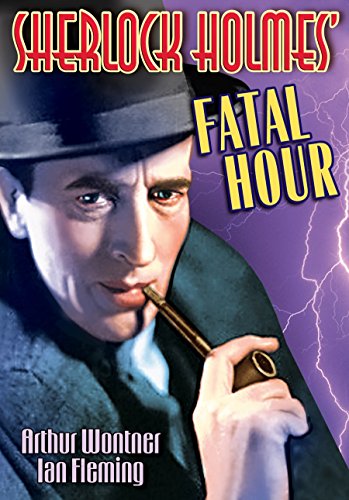
Aka – The Sleeping Cardinal
This was Arthur Wontner's first appearance as Sherlock Holmes. Four were
to follow though the next one Sherlock Holmes and the Missing Rembrandt is
a lost film. Wontner is fine as Holmes - definitely has the looks from the
book. He is a kinder gentler Holmes compared to Rathbone who often mocked
the police and cruelly teased Watson. Not a lot of edge to him but an awful
lot of talk. This is a very talkie Holmes. More like a play than a film as
it only has a few sets, all interior. Low budget.
Moriarty shows up in Holmes apartment to warn him. Nice of him. Considering
how rarely Moriarty was in the books - twice - it is rather amazing how he
captured the imagination of the public. His character has been in so many
films, TV shows and even has his own books. The criminal kingpin of England
with thousands of agents everywhere. In the film everyone thinks Holmes is
nuts, obsessed with his imaginary villain, a man of many disguises. You can
see this idea of obsession with Moriarty play out in the 1976 film The Seven
Percent Solution.
A woman comes to Holmes worried that her brother is cheating in cards because
he wins all the time. Holmes being the genius he is immediately sees the
connection between that fact and a break in at a bank in which no money is
taken. Watson as usual is of little help and always wrong. At one point he
tells Lestrade it must be suicide. But there is no gun. Well perhaps after
he shot himself in the head he got up, threw the gun out the window and sat
down again. Even Lestrade doesn't go for that one. Watson is played by Ian
Fleming (no, not that one) who does the Watson duties in three of the five
films and Mrs. Hudson is played by Minnie Rayner who was in four of these
as the landlady. Way too talkie but it is 1931 and films still tended to
be that way - but it is a reasonably decent smart straight up film. Up on
YouTube as I expect all of these are.
The Sign of the
Four (1932) – 5.0
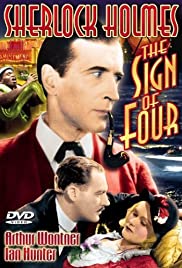
The Sign of the Four was Arthur Conan Doyle's second Sherlock Holmes story
appearing a few years after A Study in Scarlet. After these two novels Doyle
began publishing short stories in the Strand Magazine for which he began
to get paid quite handsomely. Both novels have a similar structure with Holmes
solving the mystery and then a backstory is revealed by the captured murderer.
In Study the backstory went back to the Mormon's crossing the desert while
this one originates in the Indian Mutiny. But in the books, Doyle doesn't
reveal it till near the end of the story, while in this film version for
whatever reason they have the backstory be the front story and so all is
known to the audience before Holmes even shows up. Odd directorial choice
that very much lessens the mystery and tension.
Wontner feels a bit old for Sherlock Holmes at 57, but for the 1930's he
was the face of Sherlock Holmes with his five films portraying him. In both
book and film, this is the adventure in which Watson meets Mary. If you are
at all a fan of the TV series Sherlock you might be interested in this from
the book. Holmes says of her when he hears that she and Watson will marry
"I think she is one of the most charming young ladies I ever met, and might
have been most useful if such work as we have been doing. She had a decided
genius that way." Of course in Doyle's short stories many of them still have
Watson and Holmes still living at 221 B - so it feels a bit out of order.
Perhaps at this point Doyle still didn't realize how popular Holmes and Watson
would become.
Sherlock Holmes
(1932) – 6.0
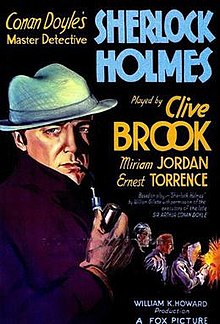
I doubt if I have ever heard of Sherlock Holmes being referred to as an "impetuous
lover" but he is in this decent enough film but which takes too many liberties
with the iconic character. It felt like this portrayal as the script is written
could have been any detective of the period. Nothing really Sherlockian about
him. First Holmes (Clive Brook) is about to be married and madly in love
and willing to give up this whole detective thing (very Bulldog Drummond
like). The horror! Holmes only loved one woman in his life - Irene Adler
- who was his ideal of a woman - smart enough to escape from Sherlock Holmes.
He is also mentoring a small boy to be a detective some day. Where is the
violin and the cocaine? And Watson barely makes an appearance. A little slow
as usual and Holmes's fiancée says to Holmes "I told you he wasn't
too bright". The nerve. Only Holmes is allowed to say that. Watson
is played by Reginald Owen who was to graduate to playing Holmes in the following
year in A Study in Scarlet.
But withstanding these rather pointless changes this is a good film in particular
a few scenes that are terrifically shot and edited. Director William Howard
who came out of the silent era brings a few of those tricks with him using
striking close-ups, montage and mysterious eerie lighting with him. In the
opening scene poor Moriarty is on trial again and sentenced to be hanged
but he swears that the judge, the prosecutor and Holmes will hang before
he does. He is played in maniacal form by Ernest Torrence who was Keaton's
father in Steamboat Bill Jr. He was to die the following year which is a
shame because he was good pulpy fodder for bad guys.
He escapes of course and goes about the business of carrying out his promise.
He also invites a group of killers from all over the world to join him -
to get in to his headquarters they have to first stop at a shooting gallery
in a fair (great scene of faces) and hit a bullseye. One of the hired killers
is from Chicago and brings a little Chicago with him. No, not thick crust
pizza - but bombs. No idea why, but the film includes a lovely comedy routine
between a bartender and a customer. The bartender is the wonderful
Herbert Mundin, who's shtick of muddled confusion always works for me.
A Study in Scarlet
(1933) – 5.0
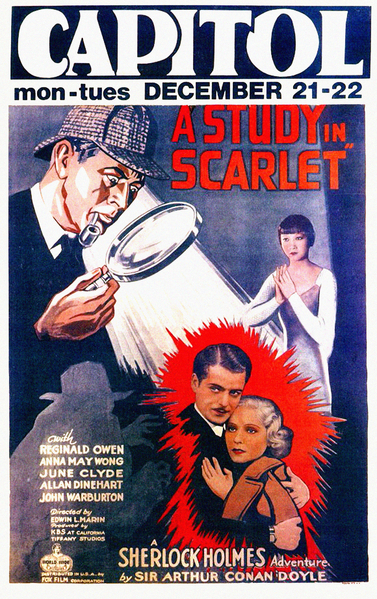
What is most remarkable about this version of Arthur Conan Doyle's A Study
in Scarlet is that it has absolutely nothing to do with the story of the
same name. Other than it of course has Holmes and Watson and the cigar brand
that is a clue in both. In fairness, in the opening credits it did say "Suggested"
by the story but a very faint suggestion it is.
A Study in Scarlet was Doyle's first foray into the world of Sherlock Holmes
- it was a novel - followed by another novel, The Sign of the Four, before
Doyle settled into his short story form. It introduces Holmes and Watson
to one another and they go off on their first case together. A dead man is
found with the word "Rache" painted on the wall and it turns out to have
a long backstory that goes all the way to America and the Mormons moving
west.
This film is about a group of thieves who have a large sum of money owed
to them and they have agreed that if one of them dies, then the others will
inherit his share (always a bad idea) - so they begin to be bumped off one
by one. The main reason to watch it is it that it co-stars the legendary
Anna May Wong. Holmes is played by Reginald Owen.
By the time of this film in 1933 Holmes had already been filmed many times
primarily in the silent era - but a few already in talkies - most of them
starring Arthur Wontner who was in five of them going up till 1937 before
Basil Rathbone took over the character for the next decade and who is still
the Sherlock Holmes most people think of.
The Triumph of
Sherlock Holmes (1935) – 5.0
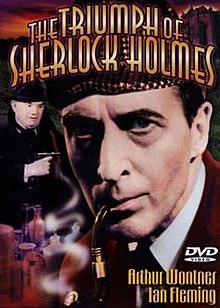
This is the fourth of the five films in which Arthur Wontner starred as Sherlock
Holmes. Wontner was highly acclaimed at the time as the perfect Holmes but
within a few years the Basil Rathbone films were to overshadow his. These
are British productions with much lower budgets than those that came out
of Hollywood - and it doesn't help that the DVDs I have were put out for
bargain bin consumption. The sound and visuals are quite murky and at times
a chore to follow. I saw that a few of them on sale now claim to have been
digitally restored which is great if true.
This is actually quite decent once I got used to this Holmes and Watson.
Wontner plays Holmes with much less dash, charisma and energy than Rathbone
- more cerebral puffing away on his pipe and Watson who is played by Ian
Fleming isn't the comic foil that Nigel Bruce was. Still not exactly bright
but as lovable as Bruce's performances are, they are miles from the Watson
of the books. This is based on Conan Doyle's The Valley of Fear, a book as
opposed to a short story, written in 1914 for The Strand Magazine. Doyle
based it on a true story of a Pinkerton detective infiltrating the Molly
Maguires. In his books Doyle often relied on a lengthy flashback as he does
here. In A Study in Scarlet the flashback took place in Utah about the Mormons;
in The Sign of the Four it was in India and Valley of Fear has a flashback
to America. The film follows the book to a large extant with a few minor
and major changes.
One of the changes is that Holmes is retiring and ready to move to the country
with Mrs. Hudson in tow. But before he leaves he receives a visitor - the
dreaded Professor Moriarty (Lyn Harding) - warning Holmes to stay retired.
For all his fame Moriarty only appeared in two of Doyle's stories - this
one and in The Final Problem where Holmes and Moriarty met their deaths (until
Doyle was forced to bring Holmes back to life a few years later). Wonter
was 60 years old at the time, so this makes sense. So he goes out to the
country to care for his bees until he gets a cipher from one of his informers
notifying him that a John Douglas (Leslie Perrins) is going to get murdered
by an agent of Moriarty. Holmes rushes off but it is too late. But Holmes
digs deeper and gets the story from his wife about her husband being a Pinkerton
detective and the gang he put behind bars looking for revenge all the way
to England. I like anything Sherlock related no matter the genre and this
was certainly passable if far from imaginative.
The Murder at
the Baskervilles (1937) – 5.0
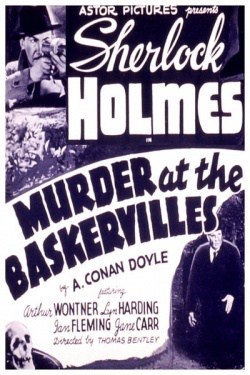
This is the final Arthur Wontner portrayal as Sherlock Holmes. You might
expect from the title that this is another version of The Hound of the Baskervilles
(which in two years was to be the kickoff film for the Basil Rathbone Holmes
series), but in fact it is mainly based on The Adventure of Silver Blaze.
A rather nifty slight of hand to bring people into the theater as this was
Doyle's best known work. The filmmakers also add a dash of Moriarty (Lyn
Harding) because why not. He is always welcome. Of the five Wontner films,
Moriarty shows up in three of them - even dying in an earlier one and being
arrested in the other - but here he is again. Audiences back then must have
had short memories.
Sherlock and Watson (Ian Fleming) are invited to visit their old friend Henry
Baskerville some twenty years after the slaying of the hound. Off they go
for a nice rest in the country, but soon crime arrives as well and Holmes
is asked to look into it by Scotland Yard and Lestrade. A horse by the name
of Silver Blaze has been stolen and two men murdered, The horse is supposed
to run in a race within a week's time. Holmes is on the track - literally
- and it leads him to . . . Moriarty who doesn't want this horse to run.
Holmes later breaks into Moriarty's impregnable fortress of solitude by .
. . taking the elevator. Didn't think of that you did you Moriarty! The video
is of dreadful quality and watching it was a chore but I wanted to finish
these films off.
This story is most famous for the Sherlock quote which we have all used at
some point in our life:
Gregory: Is there any other point to which you would wish to draw my attention?
Holmes: To the curious incident of the dog in the night-time.
Gregory: The dog did nothing in the night-time.
Holmes: That was the curious incident.
